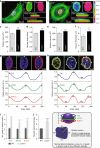Nuclear lamin A/C harnesses the perinuclear apical actin cables to protect nuclear morphology
- PMID: 29242553
- PMCID: PMC5730574
- DOI: 10.1038/s41467-017-02217-5
Nuclear lamin A/C harnesses the perinuclear apical actin cables to protect nuclear morphology
Erratum in
-
Author Correction: Nuclear lamin A/C harnesses the perinuclear apical actin cables to protect nuclear morphology.Nat Commun. 2018 Mar 13;9(1):1115. doi: 10.1038/s41467-018-03450-2. Nat Commun. 2018. PMID: 29535303 Free PMC article.
Abstract
The distinct spatial architecture of the apical actin cables (or actin cap) facilitates rapid biophysical signaling between extracellular mechanical stimuli and intracellular responses, including nuclear shaping, cytoskeletal remodeling, and the mechanotransduction of external forces into biochemical signals. These functions are abrogated in lamin A/C-deficient mouse embryonic fibroblasts that recapitulate the defective nuclear organization of laminopathies, featuring disruption of the actin cap. However, how nuclear lamin A/C mediates the ability of the actin cap to regulate nuclear morphology remains unclear. Here, we show that lamin A/C expressing cells can form an actin cap to resist nuclear deformation in response to physiological mechanical stresses. This study reveals how the nuclear lamin A/C-mediated formation of the perinuclear apical actin cables protects the nuclear structural integrity from extracellular physical disturbances. Our findings highlight the role of the physical interactions between the cytoskeletal network and the nucleus in cellular mechanical homeostasis.
Conflict of interest statement
The authors declare no competing financial interests.
Figures






Similar articles
-
The LINC-anchored actin cap connects the extracellular milieu to the nucleus for ultrafast mechanotransduction.Sci Rep. 2013;3:1087. doi: 10.1038/srep01087. Epub 2013 Jan 18. Sci Rep. 2013. PMID: 23336069 Free PMC article.
-
The perinuclear actin cap in health and disease.Nucleus. 2010 Jul-Aug;1(4):337-42. doi: 10.4161/nucl.1.4.12331. Epub 2010 Apr 23. Nucleus. 2010. PMID: 21327082 Free PMC article.
-
Decreased mechanical stiffness in LMNA-/- cells is caused by defective nucleo-cytoskeletal integrity: implications for the development of laminopathies.Hum Mol Genet. 2004 Nov 1;13(21):2567-80. doi: 10.1093/hmg/ddh295. Epub 2004 Sep 14. Hum Mol Genet. 2004. PMID: 15367494
-
The nuclear membrane and mechanotransduction: impaired nuclear mechanics and mechanotransduction in lamin A/C deficient cells.Novartis Found Symp. 2005;264:264-73; discussion 273-8. Novartis Found Symp. 2005. PMID: 15773759 Review.
-
Lamin A/C Mechanotransduction in Laminopathies.Cells. 2020 May 24;9(5):1306. doi: 10.3390/cells9051306. Cells. 2020. PMID: 32456328 Free PMC article. Review.
Cited by
-
Comprehensive analysis of the expression patterns and function of the FTO-LINE1 axis in yak tissues and muscle satellite cells.Front Vet Sci. 2024 Sep 5;11:1448587. doi: 10.3389/fvets.2024.1448587. eCollection 2024. Front Vet Sci. 2024. PMID: 39301283 Free PMC article.
-
Structural and Mechanical Aberrations of the Nuclear Lamina in Disease.Cells. 2020 Aug 11;9(8):1884. doi: 10.3390/cells9081884. Cells. 2020. PMID: 32796718 Free PMC article. Review.
-
Desmin and Plectin Recruitment to the Nucleus and Nuclei Orientation Are Lost in Emery-Dreifuss Muscular Dystrophy Myoblasts Subjected to Mechanical Stimulation.Cells. 2024 Jan 16;13(2):162. doi: 10.3390/cells13020162. Cells. 2024. PMID: 38247853 Free PMC article.
-
Role of dynamic nuclear deformation on genomic architecture reorganization.PLoS Comput Biol. 2019 Sep 11;15(9):e1007289. doi: 10.1371/journal.pcbi.1007289. eCollection 2019 Sep. PLoS Comput Biol. 2019. PMID: 31509522 Free PMC article.
-
A role for nuclear stretching and NPCs changes in the cytoplasmic-nuclear trafficking of YAP: An experimental and numerical modelling approach.Mater Today Bio. 2022 Jun 22;15:100335. doi: 10.1016/j.mtbio.2022.100335. eCollection 2022 Jun. Mater Today Bio. 2022. PMID: 35813578 Free PMC article.
References
Publication types
MeSH terms
Substances
Grants and funding
LinkOut - more resources
Full Text Sources
Other Literature Sources
Miscellaneous

